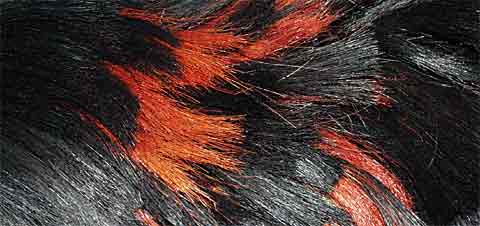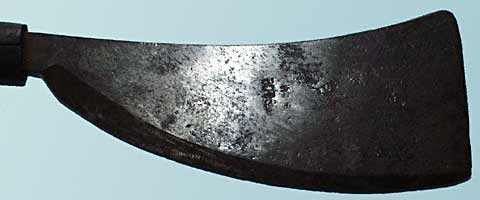Daos of the Hill Tribes of Assam and Nagaland
Detail from fig. 19 of Lord Egerton's Indian and Oriental Armour (1896). The dao on the top is facing edge up and is of a sort described by Rawson as an obsolete Konyak form with features suggesting evolution from the milemnok. The lower dao is of the later or "modern" Konyak form which persisted in use well into the 20th century.
The general purpose dao of the Naga of northeastern India usually tends to be a broad, moderately thick to thin bladed axe-like implement something like a fascine knife, used not only in war but as the Naga's primary tool. Rawson (1968) provides a great deal of interesting detail about both earlier working forms and degenerate ceremonial forms of the dao which go beyond our present consideration of the typical form of the ordinary working dao in the late 19th and early 20th centuries.A longer bladed implement from these same cultures has been termed a sword-dao by Rawson. The "modern" dao usually has a roughly triangular blade, widening along a convex curve toward the end where it reaches its maximum and where the far end is relatively square cut, that is, without a point. The blade is thickest along the back, which may be straight or gently concave in profile and thins gradually both in the axis moving from hilt to end and in the axis from back towards cutting edge. Viewing a dao, hilt to the viewer's left and cutting edge down, a chisel edge will be found on the side facing the viewer. The opposite side remains relatively flat, but holding a straight edge to the back face will disclose a very gentle roll to the edge on this side in many cases.
 |
 |
 |
 |
 |
|
|
Rawson opines that the form of the dao since the mid 19th century has been influenced by the adoption of hoes purloined from the hill side tea gardens in Assam as the raw material for the dao's manufacture; one hoe being split along its center to form two dao blanks which would each require only mild reshaping. The presence of residual hoe manufacturer's marks on such daos, such as with example 1 above, supports this observation. Traditionally, before the arrival of such a ready made supply of excellent steel, Rawson reports that the heavy use and constant losses from resharpening that the working dao suffered meant that the daos frequently became fatigued and were then reforged with the material from the old dao providing the bulk of the mass towards the spine and new material forming the edge.
The wooden handle, usually two to three times the length of the blade, is secured to the tang of the blade and reinforced by a iron ferrule. Just back from the ferrule is a rattan grip binding. The remainder of the handle may remain plain, or may be decorated with tufts of red and black goat hair located on the same side as the chiseled face of the blade to signify that the original owner had been a successful head hunter.
The Pitt-Rivers Museum on the campus of Oxford University in Oxford, England has and displays a substantial collection of Naga weapons and artifacts.
